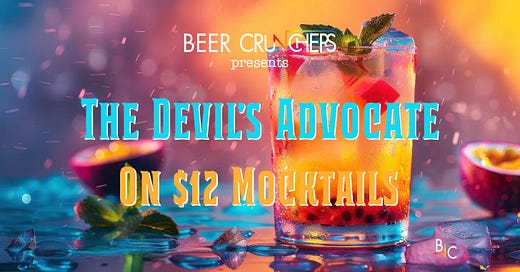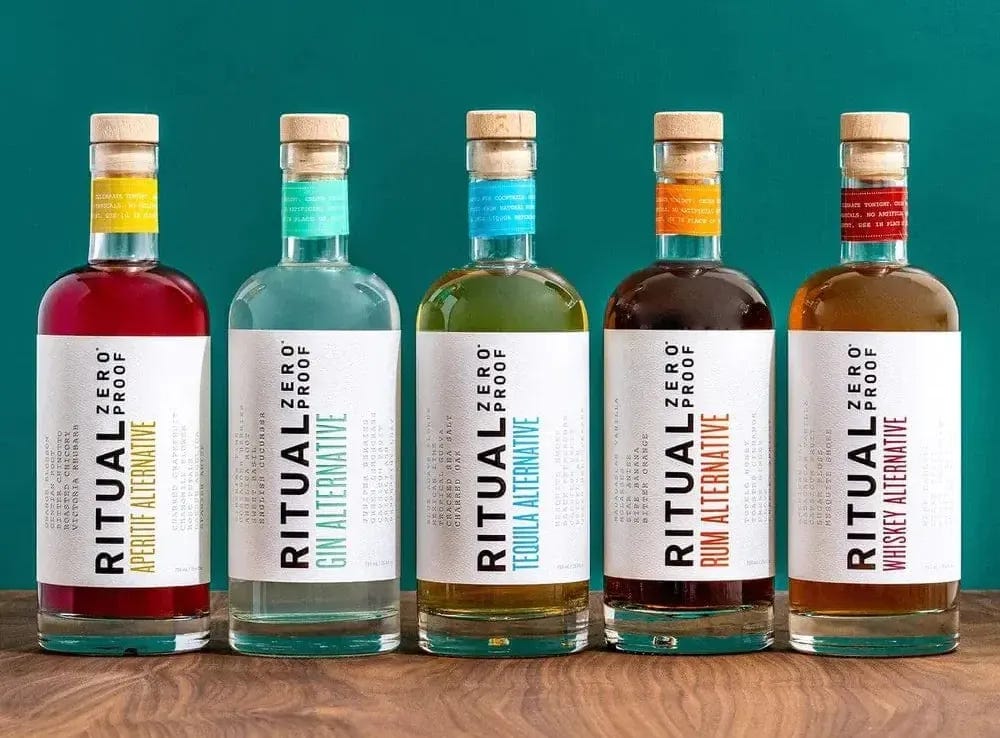Drinking culture is shifting as more consumers prioritize their health and wellness, whether through abstinence, destigmatizing the “sober curious” movement or the increase in moderation through practices such as “zebra-striping”. Concurrently, mocktails designed to mimic the complexity and flair of their boozy counterparts have skyrocketed in popularity. Many restaurants have jumped on this trend, offering intricate zero-proof cocktails to their menu to accommodate the growing demand for alcohol-free choices. An increasing number of diners, however, are questioning whether these beverages should come with a price tag nearly identical to cocktails. Defending these prices is a tall task, but the Devil’s Advocate has reemerged to convince you to support high-priced mocktails.
I caught this TikTok video of a woman (understandably) questioning why, when out at a restaurant, her mocktail cost $12. She points out that her friend’s glass of wine cost $6, but it sounds like the wine price was due to a happy hour special to draw people in, so we won’t hold that part against the establishment. Instead, assume that a regular-priced cocktail with alcohol cost $14 at this upscale spot, by comparison.
Credit: @SarahintheCity
I appreciate the creator’s tact and genuine curiosity, wondering if there’s a reasonable explanation. While skeptical, she’s open-minded. She acknowledges her assumption that alcohol is the most expensive ingredient in a cocktail, but suggests that perhaps she’s wrong and it’s the other ingredients. Why is the non-alcoholic version so similar in price?
There actually number of reasons, but most of them are secondary such as:
Ingredient Quality and Complexity: Many mocktails are made using high-quality, fresh ingredients, including exotic fruits, herbs, spices, and homemade syrups. Keeping each of these options – some of which have short shelf lives – available at all times is a lot different than a soda gun hooked up to the water line.
Labor and Skill Involved: The preparation process can require skill and precision no different than crafting a cocktail. Bartenders or mixologists create balanced and flavorful drinks that involve knowledge of flavor profiles, presentation, and sometimes even advanced techniques like infusions or foams. Their workload gets backed up on busy nights and mocktails can contribute equally to that burden.
Psychology: For many diners, mocktails offer an elevated drinking experience, especially in social settings where they want to participate in the same vibe as others without consuming alcohol. The price reflects not just the drink itself but the experience of being part of the cocktail culture, even without the alcohol. Many prefer to call them Zero Proof Cocktails for related reasons, and offering them at a similar price point ensures that those abstaining from alcohol are made to feel just as elevated as those ordering cocktails.
Cost of Non-Alcoholic Alternatives: Increases in moderation and alcohol-free lifestyles have sparked a demand for an array of options. This, in turn, has led to a rise in the use of non-alcoholic spirits in zero-proof cocktails. As niche products designed to simulate the intensity of alcohol, their costs wind up being the same or even higher due to expensive ingredients and, especially, their lack of scale compared to leading alcohol brands.
The Real Reason 🤌
Although these reasons help support the high price of mocktails, it’s understandable if you're still not fully convinced. Most persuasive is a simple fact: the majority of the restaurants in question rely on alcohol sales as the core source of margin, making up for the unviable profitability on food alone. If all customers ordered an entree plus a $3 Sprite, the economics of many restaurants would fall apart.
According to a special report from CGA by NIQ and SIP by Pernod Ricard from Q1-2024, 32% of global consumers said they are drinking or planning to drink less frequently than they were a year ago. Yet, exactly half (50%) of people moderating their consumption still visit the On Premise weekly. The same report found that 51% (34% globally) of bartenders in the US felt alcohol-free spirits in cocktails would be a big trend in 2024. More recently, Q1-2025 VIBE CGA by NIQ data shared that now 76% of US bartenders feel that alcohol-free spirit alternatives will be a trend in non-alcoholic cocktails in 2025.
As more customers choose non-alcoholic options, the restaurant needs alternative margin-generating weapons to increase the profitability of each check. Beyond the obvious lower dollar amount earned on a classic non-alcoholic drink, the alcohol isn’t flowing, which likely coerces fewer second and third drinks, not to mention impulsive dessert purchases.
The alternative, and the reason I hope you’ll join the Devil’s Advocate in actually supporting expensive zero proof cocktails, is that the restaurant raises the price of each food menu item to pad the loss in alcohol sales. Personally, I’d rather tax the mocktail drinker than watch the price of food increase further.
Check Please 🧾
As diners continue moderating their alcohol consumption, mocktails offer an elevated, inclusive experience that matches the social vibe of traditional cocktails. In some cases, these drinks are crafted and presented with just as much flair and elegance as a full-strength drink. At first glance, the price may seem irrational. But there’s a lot going on behind the scenes: ingredient quality, labor, and the overall need for restaurants to stay profitable, to name a few things. Diners frustrated by add-on service fees that cause their bill to reach the length of a CVS receipt should accept the higher zero-proof cocktail price point if it helps avoid these unwelcome charges.
Though not a solution for all circumstances, including designated drivers, the rise of Delta-9 THC-infused beverages has the potential to bridge the gap and overcome diner skepticism about the value proposition of a non-alcoholic drink. As this trend continues to gain exposure at bars and restaurants, we may find that zero-proof THC-infused cocktails and other beverage formats can maintain an upscale experience while also bringing greater perceived value, all at similar price points.
The Devil's Advocate: 0% White Claw
You may think I’m the type of guy who would poke fun of the concept of “Non-Alcoholic Hard Seltzer”, like 0% ABV White Claw which was recently announced, and you might be right. I’m not going to do that today though because I enjoy a challenge and know that a lot of smart people came to this decision. So instead I’m going to take the side of the argumen…








Honestly, I came into this article thinking I was going to disagree with your take completely, but I see where you're coming from. I am just not sure average consumers are going to see it the same way. I can see expensive mocktails doing well at expensive restaurants, but for anything other than high-class fine dining establishments, it's still going to feel like a ripoff.
I don’t know. People in my circles are starting to call mocktails Snapple and pushing back on price. I’m not saying this is fair, but if we really do have a recession, I think the premium priced NA beverage could come under extra pressure.